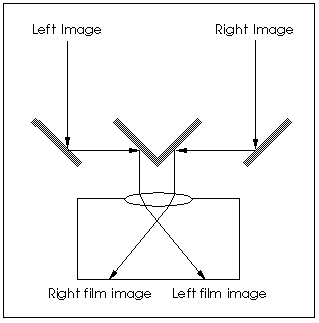How Beamsplitters / Beamspreaders Work
"Beamsplitters"
A beamsplitter involves a system of mirrors and/or prisms which fit in front of the normal lens of an SLR, and "split"
the film into a left and right version. A model using mirrors operates like this:

Currently manufactured beamsplitters includes the Franka beamsplitter,
and the Pentax beamsplitter.
In most cases, the beamsplitter itself is used with an attachment as a slide viewer. The images
may also be free-viewed.
Beamsplitters generally introduce vignetting around the image frames, and are sensitive to the f/stop
used. The more wide-open the lens (numerically smaller f/stop), the less this is a problem. But those lens
settings work against good 3D, in which you generally want to have as much depth-of-field as possible.
In particular, the center band between the two photos gets larger as the camera lens is stopped down.
As a rule of thumb, generally f/stops should be kept at f/8 - f/5.6 or more; going down to f/11 will
generally give unacceptable results.
Pros and Cons of beamsplitters
Beamsplitters have strengths and weaknesses. Some of these are:
Advantages:
- Depending on the unit, can be considerably lower cost than a dedicated 3D camera. Some
units actually cost more than a dedicated 3D camera, however.
- You can use your existing SLR with all it's features (i.e autofocus, autoexposure,
faster shutter speeds than '50s 3D cameras, etc.)
- Stereo alignment is automatic - no need to cut and mount slides or worry about the
stereo window.
Drawbacks:
- The dark band between the two images may fool auto-exposure systems.
- Beamsplitters introduce
keystone distortion
because the outer mirrors are not exactly at a 45 degree angle. This is not a
problem when the beamsplitter itself is used as a viewer, but can be if, for example,
a print is made and viewed by free-viewing. Many users do not find this objectionable, but you might.
- It is important to keep the beamsplitter level with the camera. Some models stay in
place better than others.
- If the front element of your SLR lens rotates as focus is adjusted, a beamsplitter
may be a lot of trouble to use.
- The "tall thin" format of most beamsplitters can be compositionally challenging.
Here are some example photos (contains 29K of JPEG files),
showing the effects of f/stop, and beamsplitter keystoning.
Beam spreaders
A beamsplitter (such as is used in the Loreo camera) is a similar concept, but replaces the single lens
in a beamsplitter with two lenses. This has the effect of "spreading" out the stereo base. For example, the
Loreo camera uses two small lenses which each take a half-frame image (i.e. each one exposes half of a 24x36mm
film frame, for two 18x24 side-by-side images). Without a beamspreader, this would result in a stereo image
with a stereo base (lens separation) of 18mm. The beam spreader mirror
arrangement simply widens out the
stereo base to a more normal value (i.e. 65mm).
Rocky Mountain
Memories
Return to RMM 3D Encyclopedia index
[Contact Us]
| [Home] |
[Order Form]

